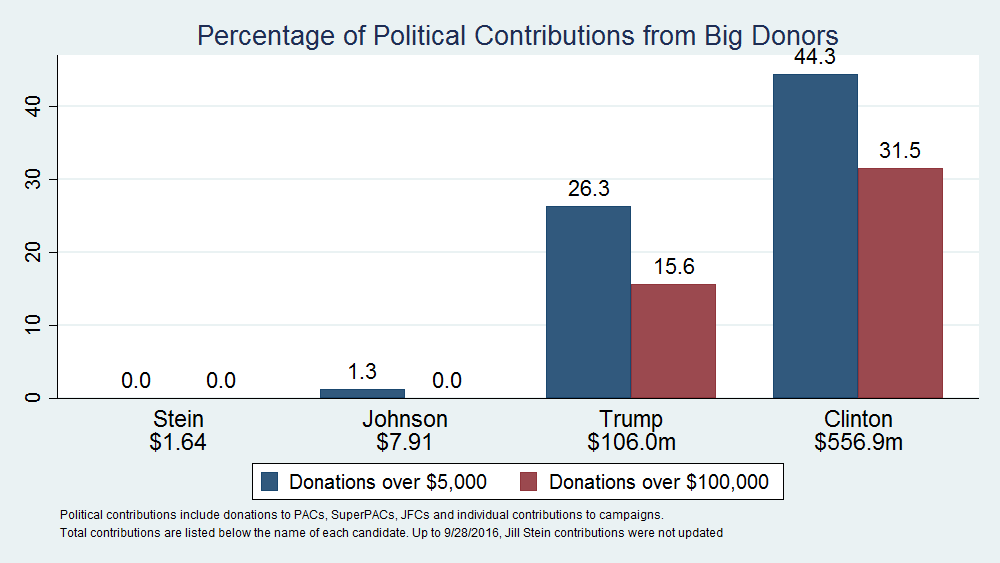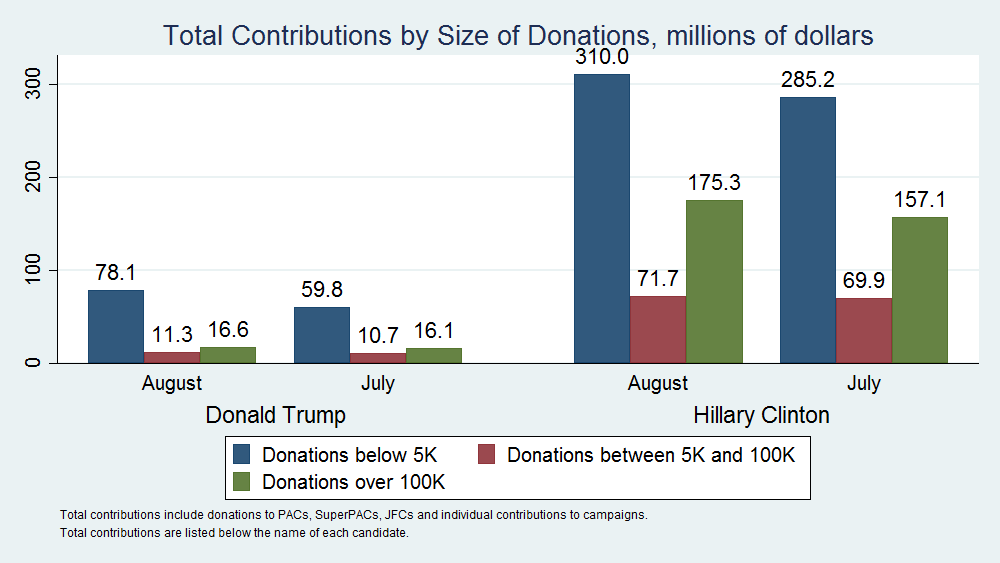October 5, 2016: Donald Trump Keeps Losing Affection from Big Donors, While Clinton Maintains It
As of August 31, 31.5 percent of Hillary Clinton’s contributions come from donors who contributed more than $100,000. Over the last three indices calculated by the Stigler Center since June, there has been a reduction in the fraction of funds raised in support of Trump from large donors.
Throughout this election cycle, Hillary Clinton has consistently held a significant fund-raising advantage over Donald Trump, especially among big donors. While the Trump campaign relies heavily on small, digital donations, Clinton has raised a significant portion of her contributions from donors giving $100,000 or more.
The latest update of the Campaign Financing Capture Index—a Stigler Center project that tracks the attempts of large political contributors to affect public policy by focusing on the fraction of total funds raised from large donors—finds that Clinton has maintained her fundraising advantage over Trump in August.
According to Stigler Center calculations, as of August 31, 31.5 percent of Hillary Clinton’s contributions come from donors who contributed more than $100,000. Those donations increased by 0.8 percentage points from July to August. At the same time, donations over $5,000 dollars accounted for 44.3 percent of the total amount raised by Clinton.
Donald Trump’s percentage of donations from big contributors has decreased further in August. Contributions over $5,000 and over $100,000 decreased by 4.6 and 3 percentage points, respectively, in August. 26.3 percent of the $106 million raised by Trump and the PACs, super PACs and JFCs that support it came from donations over $5,000, while 15.6 percent came from donors who gave more than $100,000.

Over the last three indices calculated by the Stigler Center since June, there has been a reduction in the fraction of funds raised in support of Trump from large donors. As of August 31, the total amount raised by the Clinton campaign and the PACs, super PACs, and JFCs supporting it was $556.9 million, while for Trump the total amount raised was $106 million. Libertarian candidate Gary Johnson and Green Party candidate Jill Stein lagged far behind Clinton and Trump in the money race, collecting $7.91 million and $1.64 million respectively.
Both Trump and Clinton have raised most of their donations from donors contributing less than $5,000. For Hillary Clinton, these donations increased by $24.8 million in August, while for Donald Trump they increased by $18.3 million.

Donations given to Priorities USA action–the largest super PAC supporting Clinton– amounted to $18.4 million in August, with almost all donations collected coming from donors who gave more than $100,000. Daniel Abraham and Fred Eychaner were the biggest contributors, donating $3 million each. George Soros came in third, with a donation of $2.5 million, followed by financier Donald Sussman with a donation of $2 million.
Donald Trump’s main super PAC–Great America PAC–lagged behind Hillary Clinton’s, raising $1.04 million. 57 percent of the total came from donations above $5,000, with only 2 donors giving more than $100,000 (Lamb Steven with $250,000 and Malin Barry with $200,000).
The Campaign Financing Capture Index was launched in March. It analyzes the distribution of political contributions to presidential candidates and takes into account individual contributions and contributions made to the PACs, super PACs, and joint fundraising committees that support each candidate. It is our belief that large political contributions represent more than the mere expression of political preference and are more likely meant to influence policy in favor of the donor’s interest. When the percentage of funds raised from large donors is increasingly significant, as it has been in recent years, this problem becomes more acute.
The analysis was done based on data collected from the FEC website, and comprises individual contributions made to campaigns, main super PACs, PACs, and JFCs since the beginning of the race until August 31. The Stigler Center will publish a concentration and distribution analysis every three months until the presidential elections.

